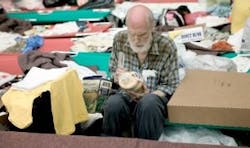How to Bend the Technology Arc to Bring Resilient Energy to those Most in Need
Houston Astrodome following Hurricane Katrina. Credit: FEMA Photo Library
Today’s drive to develop resilient energy is good for the world. But how quickly will microgrid-like technology arrive for those most in need?
That’s a question that’s worried Lew Milford, president and founder of the Clean Energy Group (CEG), an organization for years at the forefront of innovations in renewable energy funding.
Milford noticed that since Superstorm Sandy, those with money have been shoring up their resiliency and improving their energy economics with microgrids, solar-plus-storage and similiar technologies. And he’s wondered, what about those living in low-income housing, assisted living and senior facilities? Will they sit in the dark during the next big storm? Equally important, will they miss the economic benefits of these new technologies?
Out of this concern came a new drive by Milford’s group to “bend the technology arc” and bring resilient energy to those living on the edge — ideally for free.
Arguably immoral
“In some places you have a situation where people are really at risk, and at best there is a diesel generator just sitting in a building waiting to fail,” Milford said. “That is not only stupid, but arguably immoral, when you have the technology combination that can do a better job.”
The Vermont-based organization is promoting a financial model that involves offsetting resilient energy costs by using onsite energy and storage to reduce a building’s demand charges. The building also can defray technology costs by selling ancillary services to the wholesale grid.
Backed by several foundations, CEG is working with cities, developers and building owners. In return for its technical and financial assistance, the group asks that the projects make available contracts, funding and performance data. CEG plans to analyze the results publish papers on the projects in the hope that other affordable housing developers will replicate the successes. The group has a paper due out shortly on the economics of energy resiliency for affordable housing.
“The idea is to draw conclusions and disseminate information based upon actual projects, and to get as many projects underway as possible as the smart grid develops in those areas that address public needs,” said Robert Sanders, CEG senior finance director.
About a dozen such projects are in the works; some under agreement and others in evaluation, with organizations and businesses like green developer Jonathan Rose Companies, the National Housing Trust, Chicago’s Affordable Community Energy (a subsidiary of Hispanic Housing Development Corp.) and the City of Baltimore.
CEG expects the first of these projects, an affordable housing facility in New York City, to be announced by the end of the year. The facility will use solar plus storage.
“A lot of communities are planning for resiliency. The gap is turning that into projects and really getting stuff done that will prevent harm the next time around. We’re trying to close that gap,” Milford said.
If Musk can do it…
So far, developers approached by CEG appear intrigued by the idea of bringing microgrid-like technology to affordable housing, Milford said.
“None that we have met have said, we are not interested. They read the paper like everybody else. They see [Elon] Musk, Tesla and Walmart doing it. They say, why aren’t we?” Milford said.
In addition to working with developers, CEG acts as a policy advocate to encourage public funding and energy rules that make it easier to build resilient energy projects for those most in need.
For now, Milford sees solar plus storage as a more likely play than a full-fledged microgrid for affordable housing because it is less expensive. CEG is focusing on resiliency and islanding on a building by building basis, rather than linking the buildings as combined load into a microgrid, he said.
Most of all, CEG wants to be sure that lower income people do not miss out on the advantages of resilient energy for years and years, waiting for the prices to drop — as they did with solar energy.
“Virtually every analyst says that storage today is where solar was 10 or 15 years ago. It certainly is too expensive, but those numbers, with volume, are going to dramatically drop. Storage will take the same cost curve down as solar has,” he said. “But if you wait for the market to play out…the people who need the resiliency are going to wait a long time.”
Read more articles like this by subscribing to our free Microgrid Knowledge newsletter.







